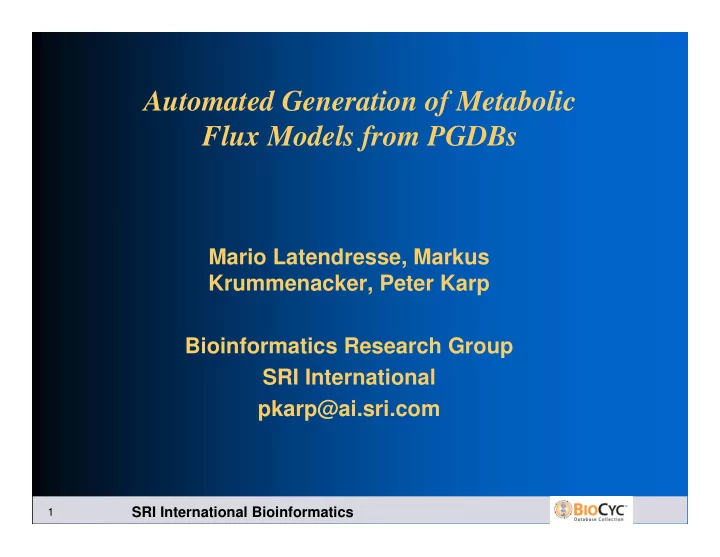

Automated Generation of Metabolic Flux Models from PGDBs Mario Latendresse, Markus Krummenacker, Peter Karp Bioinformatics Research Group SRI International pkarp@ai.sri.com SRI International Bioinformatics 1
Approach: FBA Model as a Database � Store and update metabolic model within Pathway Tools � Export to constraint solver for model execution � Fast generation of metabolic model from annotated genome � Close coupling to genome and regulatory information � Extensive PTools schema � Associate a wealth of information with each model � Unique identifiers for each component of the model � Extensive query and visualization tools � Visualize reaction flux and omics data using overviews � Debug/validate model using Pathway Tools � Reachability analysis � Dead-end metabolite analysis � Visual inspection on cellular overview SRI International Bioinformatics 2
Issues: Reaction Balance and Protonation � Reaction balancing � Balance checked in reaction editor � Bulk balancing tool � Majority of MetaCyc reactions are balanced � Use MetaCyc update tool to propagate MetaCyc updates to your PGDB � Protonation � Formerly our compound structures were protonated to inconsistent states � In MetaCyc 13.0 and forward, all structures are computationally protonated to cellular pH 7.3 � Using Marvin software from ChemAxon � Reaction balances adjusted computationally by adding protons SRI International Bioinformatics 3
Issues: Generic Reactions � Examples: � 1.1.1.182: NAD(P)+ + shikimate � NAD(P)H + 3-dehydroshikimate + H+ � 1.3.99.3: a 2,3,4-saturated fatty acyl CoA + FAD � FADH2 + a 2,3-dehydroacyl-CoA � Introduced many years ago to simplify descriptions of reactions and pathways � Problem: Without special smarts, reactions involving instances and their classes are not connected within models � a 2,3,4-saturated fatty acyl CoA � decanoyl-CoA SRI International Bioinformatics 4
Generic Reactions: Solution � Generate instantiated reactions from generic reactions � A + b � C � a1 + b � c1 � a2 + b � c2 � a3 + b � c3 � Generate all reaction instantiations � Prune those that are unbalanced SRI International Bioinformatics 5
Generation of FBA Models from PGDBs � Export PGDB to SBML � (Thanks to Jeremy Zucker) � Coming soon: reaction instantiation � Export of PGDB to GLPK / CPLEX SRI International Bioinformatics 6
Export of PGDB to GLPK � A single Lisp function will: � Generate a GLPK .lp file containing FBA constraints from � PGDB reactions � Supplied biomass components � Specified nutrients � Allowed waste products � Additional set of reactions to include or reject � Run GLPK on this file � Parse the GLPK output file � Determine if it found a solution � Generate another file mapping fluxes to PGDB reactions � Display the resulting fluxes on the Cellular Overview SRI International Bioinformatics 7
Results: E. coli K-12 � E. coli model generated from EcoCyc is solvable by GLPK � Lipids are missing � We have not yet verified magnitudes of fluxes � Many reactions where fluxes appear are reasonable � Flux is zero in unexpected places � High fluxes are present in unexpected places SRI International Bioinformatics 8
Results: BioCyc Buchnera aphidicola � No solution found � Search for largest subset of biomass components for which a non-zero flux can be found: � 3 compounds found SRI International Bioinformatics 9
Model Gap Filling � Initially try gap filling on a partial E. coli model � Full E. coli model F contains 1471 reactions � Define base set B of 1,000 randomly chosen reactions from F � Define extension set E of 471 remaining reactions of F � Define optimization problem to GLPK to find minimal extension of B from E that yields non- zero solution � GLPK found a set of 60 such reactions from E SRI International Bioinformatics 10
Recommend
More recommend